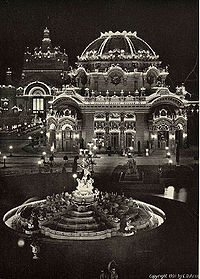
Temple of Music
Encyclopedia


Pan-American Exposition
The Pan-American Exposition was a World's Fair held in Buffalo, New York, United States, from May 1 through November 2, 1901. The fair occupied of land on the western edge of what is present day Delaware Park, extending from Delaware Ave. to Elmwood Ave and northward to Great Arrow...
which was held in Buffalo, New York
Buffalo, New York
Buffalo is the second most populous city in the state of New York, after New York City. Located in Western New York on the eastern shores of Lake Erie and at the head of the Niagara River across from Fort Erie, Ontario, Buffalo is the seat of Erie County and the principal city of the...
, in 1901. U.S. President William McKinley
William McKinley
William McKinley, Jr. was the 25th President of the United States . He is best known for winning fiercely fought elections, while supporting the gold standard and high tariffs; he succeeded in forging a Republican coalition that for the most part dominated national politics until the 1930s...
was assassinated
William McKinley assassination
The assassination of William McKinley occurred on September 6, 1901, inside the Temple of Music located on the grounds of the 1901 Pan-American Exposition in Buffalo, New York...
inside the building on September 6, 1901. The structure, like most of the other buildings at the exposition, was demolished when the fair ended.
The building
The Temple of Music was designed by architects August C. Esenwein and James A. JohnsonJames A. Johnson (architect)
James Addison Johnson was a Buffalo, New York architect known for his design of various architectural landmarks and his use of decorative work that many consider a foreshadowing of art deco design....
for the Pan-American Exhibition, to serve as a concert hall and ceremonial stage. It was built at a cost of $85,000 (well over $1,500,000 in 2008 dollars), it was an eclectic combination of various architectural elements. Its major influence was the Italian Renaissance
Italian Renaissance
The Italian Renaissance began the opening phase of the Renaissance, a period of great cultural change and achievement in Europe that spanned the period from the end of the 13th century to about 1600, marking the transition between Medieval and Early Modern Europe...
style, and it complied with the Exposition's Board of Architects' overall plan for the exhibition, called the Free Renaissance style. Like most of the major structures at this World Fair
World fair
World Fair can refer to:* Expo , a large public exhibition* This World Fair, an American rock band...
, the Temple of Music was extensively electrified, both internally and externally.
The style
The Temple's dome rose 180 feet (54.86 m) above the ground floor and the hall itself had seating for over 2,000 people. According to Chuck LaChiusa, a Buffalo native and retired City Honors English teacher, "The building was colored in light yellows, with gold and red trimmings, and the panels in the dome were in light blue, producing an extremely beautiful effect." Four ornate sculptureSculpture
Sculpture is three-dimensional artwork created by shaping or combining hard materials—typically stone such as marble—or metal, glass, or wood. Softer materials can also be used, such as clay, textiles, plastics, polymers and softer metals...
s, representing sacred music, lyric music, music of the dance, and heroic music, executed by Isodore Konti, graced the four entrance portals into the building. The Temple's appeal lay in its spacious interior and new use of lighting. Although the exterior was a great sight, the interior was also impressive. The Temple of Music had seating for over 2,000 people and possessed one of the largest pipe organs ever built in the United States. The organ is now at St Louis church at 780 Main St Buffalo, NY , pictures of the organ can bee seen at :http://www.skyscrapercity.com/showthread.php?t=656112
The creator
August Esenwein was born in Esenwein-Virnsberg, in the Kingdom of Wuertemburg, South Germany in 1856. The family moved to the United States in 1861 and returned to Germany in 1871, where August went to private elementary schools. He attended the University of Stuttgart for five years, studying architecture and engineering. After graduation, Esenwein went to Paris, where he worked as a draughtsmanDraughtsman
A draughtsman or draftsman , is a person skilled in drawing, either:*drawing for artistic purposes, or*technical drawing for practical purposes such as architecture or engineering...
.
After two years in Paris, Esenwein emigrated to the United States and settled in Buffalo, where he worked as an architect. The Temple of Music was Esenwein's submission to an architectural competition for the Pan American Exposition and it won first place. He went on to design three more buildings for the Exposition: the Administration Building, Alt Nurnberg, and the brick-art gallery. Esenwein also served on the Pan-American Board of Architects.
The assassination
The Temple of Music is primarily remembered today as the site of the assassinationWilliam McKinley assassination
The assassination of William McKinley occurred on September 6, 1901, inside the Temple of Music located on the grounds of the 1901 Pan-American Exposition in Buffalo, New York...
of President William McKinley
William McKinley
William McKinley, Jr. was the 25th President of the United States . He is best known for winning fiercely fought elections, while supporting the gold standard and high tariffs; he succeeded in forging a Republican coalition that for the most part dominated national politics until the 1930s...
. On September 5, 1901, McKinley delivered a speech on tariffs and foreign trade at the exposition. The following day, designated as "President's Day" at the exposition, McKinley was shot by Leon Czolgosz
Leon Czolgosz
Leon Czolgosz was the assassin of U.S. President William McKinley.In the last few years of his life, he claimed to have been heavily influenced by anarchists such as Emma Goldman and Alexander Berkman.- Early life :...
while greeting the public at the Temple of Music. McKinley died one week later in Buffalo.

